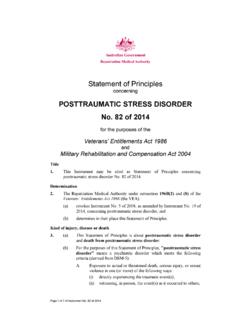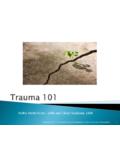Transcription of Bleeding Control (B-Con) Basic
1 Bleeding Control (B-Con) Basic Copyright 2017 by the American College of Surgeons Overview Mass Casualty Incidents (MCIs): 3-fold increase in number of active shooting events since 2008 50% occur at businesses and 33% in schools 50+ domestic terrorist attacks since the Oklahoma City Bombing in 1995 294 mass shootings in 2015 alone, more than one per day, is unfathomable. 45 shootings at schools and over 142 such incidents during which a firearm is discharged in a school building or on a school campus since the Sandy Hook Massacre. Hemorrhage Control Saves Lives: 35% of pre-hospital deaths due to hemorrhaging 40% of deaths in the first 24 hours after a traumatic event is due to hemorrhaging 20 minutes to hours for medical professionals to arrive on scene or for patients to be delivered to medical facilities Using these concepts, the military has substantially decreased battlefield deaths.
2 What everyone should know to Control Bleeding Bleeding Control Basic v. This educational program is the product of a cooperative effort by: The Hartford Consensus The American College of Surgeons Committee on Trauma The Committee on Tactical Combat Casualty Care The National Association of Emergency Medical Technicians The focus of this program is on: Introduction | Principles | A-Alert | B- Bleeding | C-Compression | -The immediate response to Bleeding -Recognize life-threatening Bleeding -Appropriate ways to stop the Bleeding The help given by an immediate responder can often make the difference between life and death, even before professional rescuers arrive. With the right training, YOU can help save lives! WARNING! Some of the images shown during this presentation are graphic and may be disturbing to some people. Bleeding Control Basic v.
3 Introduction | Principles | A-Alert | B- Bleeding | C-Compression | Why Do I Need This Training? Work-related injuries Motor vehicle crashes Mass shootings Bombings Home injuries Introduction | Principles | A-Alert | B- Bleeding | C-Compression | Bleeding Control Basic v. Primary Principles of Immediate Response Ensure your own safety The ABCs of Bleeding A Alert call 9-1-1 B Bleeding find the Bleeding injury C Compress apply pressure to stop the Bleeding by: the wound with a clean cloth and applying pressure by pushing directly on it with both hands, OR a tourniquet, OR (filling) the wound with gauze or a clean cloth and then applying pressure with both hands Introduction | Principles | A-Alert | B- Bleeding | C-Compression | Bleeding Control Basic v. Primary Principles: Safety Before you offer any help, you must remain safe If you become injured, you will not be able to help the victim Initiate care if the scene is safe for you to do so If, at any time, your safety is threatened, attempt to remove yourself from danger and find a safe location Protect yourself from blood-borne infections by wearing gloves, if available Introduction | Principles | A-Alert | B- Bleeding | C-Compression | Bleeding Control Basic v.
4 Primary Principles: ABCs of Bleeding A Alert Get help Call 9-1-1 yourself, OR Tell someone to call 9-1-1 Alerting 9-1-1 will notify and get emergency medical responders and, depending on the situation, police officers to respond to the scene Introduction | Principles | A-Alert | B- Bleeding | C-Compression | Bleeding Control Basic v. Primary Principles: ABCs of Bleeding Find where the victim is Bleeding from Open or remove the clothing so you can see the wound Look for and identify life-threatening Bleeding Blood that is spurting out of the wound Blood that won t stop coming out of the wound Blood that is pooling on the ground Clothing that is soaked with blood Bandages that are soaked with blood Loss of all or part of an arm or leg Bleeding in a victim who is now confused or unconscious B Bleeding Introduction | Principles | A-Alert | B- Bleeding | C-Compression | Bleeding Control Basic v.
5 Primary Principles: ABCs of Bleeding B Bleeding (continued) What is life-threatening Bleeding ? Blood soaking the sheet or clothing Photo courtesy of Norman McSwain, MD, FACS, NREMT-P. Blood spurting out of a wound Introduction | Principles | A-Alert | B- Bleeding | C-Compression | Bleeding Control Basic v. Primary Principles: ABCs of Bleeding B Bleeding (continued) Wounds That Can Lead to Death from Bleeding (1 of 3) Arm and Leg Wounds Most frequent cause of preventable death from injury Bleeding from these wounds can be controlled by direct pressure or a tourniquet Photo courtesy of Peter T. Pons, MD, FACEP. Introduction | Principles | A-Alert | B- Bleeding | C-Compression | Bleeding Control Basic v. Primary Principles: ABCs of Bleeding B Bleeding (continued) Wounds That Can Lead to Death from Bleeding (2 of 3) Torso Junctional Wounds Neck, shoulder, and groin Bleeding can be controlled by direct pressure and wound packing Introduction | Principles | A-Alert | B- Bleeding | C-Compression | Bleeding Control Basic v.
6 Primary Principles: ABCs of Bleeding B Bleeding (continued) Wounds That Can Lead to Death from Bleeding (3 of 3) Chest and Abdominal Injuries -Front, back, or side -Usually cause internal Bleeding This Bleeding CANNOT be stopped outside the hospital These victims need rapid transport to a trauma center Identify these patients to EMS providers when they arrive Multiple gunshot wounds Photo courtesy of Peter T. Pons, MD, FACEP. Introduction | Principles | A-Alert | B- Bleeding | C-Compression | Bleeding Control Basic v. Primary Principles: ABCs of Bleeding C Compression: Stop the Bleeding Ensure your safety. Look for life- threatening Bleeding . Is a trauma first-aid kit available? Introduction | Principles | A-Alert | B- Bleeding | C-Compression | Bleeding Control Basic v. Primary Principles: ABCs of Bleeding C Compression: Stop the Bleeding No Ensure your safety.
7 Look for life- threatening Bleeding . Is a trauma first-aid kit available? Introduction | Principles | A-Alert | B- Bleeding | C-Compression | Bleeding Control Basic v. Primary Principles: ABCs of Bleeding C Compression: Stop the Bleeding Use any clean cloth or gauze. Apply steady pressure directly on the wound. No Ensure your safety. Look for life- threatening Bleeding . Is a trauma first-aid kit available? Introduction | Principles | A-Alert | B- Bleeding | C-Compression | Bleeding Control Basic v. Primary Principles: ABCs of Bleeding C Compression: Stop the Bleeding (continued) Direct Pressure (1 of 3) Use your hand or fingers -Use two hands, if at all possible Effective most of the time for external Bleeding -Direct pressure can stop even major arterial Bleeding Bleeding Control requires very firm, continuous pressure until relieved by medical responders To be effective, apply pressure with the victim on a firm surface to provide support Don t release pressure to check the wound Introduction | Principles | A-Alert | B- Bleeding | C-Compression | Bleeding Control Basic v.
8 Primary Principles: ABCs of Bleeding C Compression: Stop the Bleeding (continued) Direct Pressure (2 of 3) Use any clean cloth (for example, a shirt) to cover the wound If the wound is large and deep, try to stuff the cloth down into the wound Photos courtesy of Adam Wehrle, NREMT-P. Introduction | Principles | A-Alert | B- Bleeding | C-Compression | Bleeding Control Basic v. Primary Principles: ABCs of Bleeding C Compression: Stop the Bleeding (continued) Direct Pressure (3 of 3) Apply continuous pressure with both hands directly on top of the Bleeding wound Push down as hard as you can Hold pressure until relieved by medical responders Photo courtesy of Adam Wehrle, NREMT-P. Introduction | Principles | A-Alert | B- Bleeding | C-Compression | Bleeding Control Basic v. Primary Principles: ABCs of Bleeding C Compression: Stop the Bleeding (continued) Ensure your safety.
9 Look for life- threatening Bleeding . Is a trauma first-aid kit available? Yes Introduction | Principles | A-Alert | B- Bleeding | C-Compression | Bleeding Control Basic v. Primary Principles: ABCs of Bleeding Ensure your safety. Look for life- threatening Bleeding . Is a trauma first-aid kit available? Where is the wound? Arm or leg Yes C Compression: Stop the Bleeding (continued) ? Introduction | Principles | A-Alert | B- Bleeding | C-Compression | Bleeding Control Basic v. Primary Principles: ABCs of Bleeding Ensure your safety. Look for life- threatening Bleeding . Is a trauma first-aid kit available? Where is the wound? Arm or leg Is a tourniquet available immediately? Yes C Compression: Stop the Bleeding (continued) ? Introduction | Principles | A-Alert | B- Bleeding | C-Compression | Bleeding Control Basic v.
10 Primary Principles: ABCs of Bleeding Ensure your safety. Look for life- threatening Bleeding . Is a trauma first-aid kit available? Where is the wound? Arm or leg Is a tourniquet available immediately? Yes Yes C Compression: Stop the Bleeding (continued) ? Bleeding Control Basic v. Primary Principles: ABCs of Bleeding Apply above the Bleeding site. Tighten until the Bleeding stops. Ensure your safety. Look for life- threatening Bleeding . Is a trauma first-aid kit available? Where is the wound? Arm or leg Is a tourniquet available immediately? Yes Yes C Compression: Stop the Bleeding (continued) ? Introduction | Principles | A-Alert | B- Bleeding | C-Compression | Bleeding Control Basic v. Primary Principles: ABCs of Bleeding C Compression: Stop the Bleeding (continued) The Tourniquet A tourniquet is a device that stops the flow of blood If applied correctly, the tourniquet will stop blood flow into the extremity and out of the wound Limiting blood loss may prevent the patient from going into shock or dying Photo courtesy of Norman McSwain, MD, FACS, NREMT-P.







